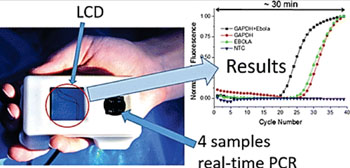Palm-Sized Device Quickly Detects Ebola Virus
By LabMedica International staff writers
Posted on 18 May 2016
The gold standard method for identifying the Ebola virus in a blood sample requires packaging samples in cooled containers and sending them to specialized laboratories, often far away from where patients live.Posted on 18 May 2016
These laboratories use a method called reverse-transcription polymerase chain reaction, or RT-PCR, to check for the virus. The prolonged testing process delays detection, treatment and real-time monitoring of viral loads in body fluids that can harbor the virus even after it is no longer detected in the blood.

Image: The handheld device that can detect Ebola Virus Ribonucleic Acid (Photo courtesy of KIST Europe).
Scientists at the Korea Institute of Science and Technology Europe (KIST, Saarbrücken, Germany) and their colleagues have designed and tested an instrument, which could simultaneously perform four RT-PCRs that included two controls and two patient blood samples. Conventional tests require several hours to more than a day for results to come in. The new process was completed in slightly over 30 minutes. The amount of blood required was 100 nL and could potentially come from just a finger prick.
The device was shown to concurrently perform four PCRs, one positive control with both Ebola and glyceraldehyde-3-phosphate dehydrogenase (GAPDH) RNA and one negative control. The device successfully detected the Ebola ribonucleic acid (RNA). In addition to diagnosing the illness, the test also yielded information about how many RNA copies each sample contained. In addition to diagnosing the illness, the experts say that the tool could also potentially help health care workers track patients' viral loads in semen, breast milk and eye fluids after recovery.
A comparison of threshold cycles (CT) from the two samples provided relative quantification. The entire process, which consisted of reverse transcription, PCR amplification, and melting curve analysis (MCA), was conducted in less than 37 min. The next step will be integration with a sample preparation unit to form an integrated sample-to-answer system for point-of-care infectious disease diagnostics. The study was published on April 11, 2016, in the journal Analytical Chemistry.
Related Links:
Korea Institute of Science and Technology Europe













